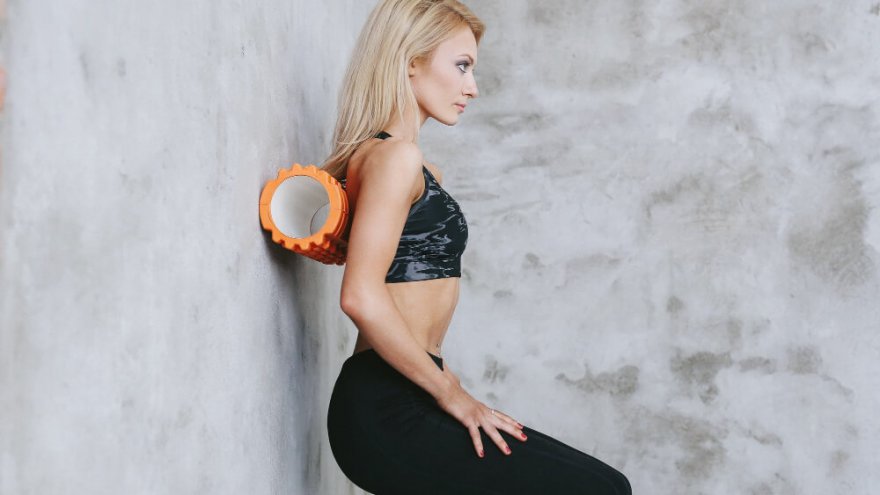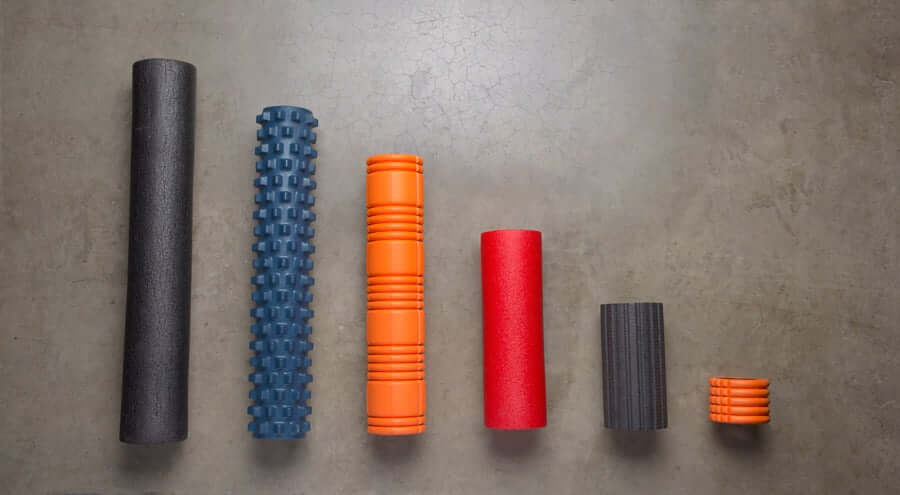Here’s What You Need to Know About Foam Rolling!

Even though there are many things that runners banter back and forth on, the benefits of foam rolling are not usually one of them.
Learning how to foam roll can be a life-changing experience for runners and non-runners alike.
Why Should You Use a Foam Roller?
To understand why foam rolling is important, you have to understand how it works. Using a foam roller is a form of self-myofascial release. That means that when you use a foam roller, you are loosening up the fascia to eliminate scar tissue and the adhesion of soft tissue.
Fascia is the connective tissue consisting of densely packed collagen fibers surrounding each muscle in your body. With consistent running, the deep tissue ‘reacts’ by thickening and shortening overtime to protect the underlying muscles.
The restricted fascia then leads to adhesions that may result in muscle soreness, restriction of your range of motion, changes in your gait, and injury. Releasing the fascia may clear up or prevent all of the issues. This is where the foam roller comes into play.
A foam roller can also target trigger points or ‘knots’ that have developed in muscles. Once your fascia is loosened up, muscles elasticity increases.
A loosened-up fascia also contributes to increased blood flow and improved mobility, balance, and gait.
The Correct Way to Foam Roll: 8 Key Steps
It can be uncomfortable to use a foam roller, so it is important to remember that less can be more, especially if you are a beginner.
As you get acclimated to foam roller exercises, you can adjust the intensity based on how your body responds. When you roll, you need to skirt the delicate balance between discomfort and pain.
Although it is normal to feel uncomfortable, it should not hurt to foam roll.
There are some important steps you should follow when using your foam roller:
- Identify the sore area or specific area of muscle tightness.
- Hold your body to lower the targeted area on the roller slowly.
- Slowly lower your body onto the foam roller just to the point of discomfort. Remember: it should not hurt.
- When on the roller, hold for anywhere from 15-60 seconds.
- Note that you can “hold” on the roller for pressure as a precursor to rolling.
- Once you are okay with the feeling of putting pressure on the roller, you can start to roll back and forth slowly. This adds stimulation to the impacted area.
- Slowly roll back and forth along the muscle. Be certain to stop and hold in areas that seem to need more specific attention.
- Adjust your body periodically to find the most effective technique.
How Do You Use a Foam Roller for Beginners?
When you are brand new to foam rolling, you need to proceed slowly and carefully. Start with a foam roller that is not too dense. You need to be certain you are balancing very carefully on the roller not to use your balance.
Do not try too hard to roll in the beginning. You can just put some pressure on in the beginning, then eventually move forward with the rolling.
Beginners need to be very careful not to be too aggressive, as new users make a common mistake.
How Do You Know If You’re Foam Rolling Correctly?
There are a few indicators that you are using your foam roller the right way.
First, when using it – you get that “hurts so good” feeling that is pressure but not pain. You will also notice that the knots in your muscles feel looser after using the roller.
You should never feel pain when using your roller. In addition, a roller should not cause bruising.
Never use a foam roller that is too dense for the body part you are working on.
Avoid a very stiff, nubby roller if you are rolling a very sensitive area or muscle group.
Why Does Foam Rolling Hurt So Much?
If you have pain while foam rolling, you may be putting too much direct pressure on a tender spot or a sore muscle. It could also indicate that you are using too dense of a foam roller or that you need a smooth roller instead of one with nubs.
Although you will often experience some discomfort when using a roller, it should not cause pain.
Most people report feeling relaxed after a good session with their roller.
Are Bumpy Foam Rollers Better?
Textured foam rollers are meant to work much like the hands of a masseuse. The ridges, knobs, or bumps on a roller can help to target your muscles more effectively.
There are multiple types of rollers.
A classic foam roller has a cylindrical shape and is approximately three feet long and six inches in diameter. It is generally made of polyethylene foam or EVA and can be color-coded according to firmness. The softest rollers are usually white, with black being the firmest.
However, a number of variations on the classic, log-shaped foam roller are also available. This includes shorter rollers; soft, hollow rollers; and rollers with knobs or ridges for added pressure.

As a general rule of thumb, start off with a softer, even-surfaced roller if you’re new to foam rolling. Using a super firm roller with knobs or spikes from the get-go may cause unnecessary pain and even bruising or put you off foam rolling altogether.
Instead, ease into it and gradually work your way up to a firmer roller or one with bumps over time.
Can Foam Rolling Be Harmful?
Most people find foam rolling to be safe, especially if done correctly.
There are some things to remember.
- Never roll over joints and bony areas, like your kneecaps.
- Don’t keep at it for too long. You should not put pressure on one spot for a long period of time. Believe it or not, you can get too much of a good thing. Stick to foam rolling for short intervals.
- Don’t use a fast-rolling action. Your brain needs time to coax your muscles into relaxing and adapting to the compression, so don’t make your rolling action too fast. Short, slow rolls are ideal.
- Don’t roll directly where you feel severe pain. Attempting to roll out inflamed areas may increase tension as well as inflammation. Instead, use a system where you roll indirectly before you go direct. This means you should spend a bit of time working in the region immediately surrounding painful areas before using larger, sweeping motions over the entire affected area.
- Don’t over-zealously roll the lower back. Foam rolling your lower back may put too much pressure on the bony part of your spine, thereby contributing to back pain. If you have chronic lower-back pain, there is a good chance that the problem is caused at a location lower down in your body, such as the hips or hamstrings.
- Don’t apply too much pressure when rolling your IT bands. Instead, manage the pressure that you place on the IT band by putting your top foot on the floor and supporting the body weight.
Is it Okay to Foam Roll Every Day?
Foam rolling every day is very good for you. Many coaches, personal trainers and physical therapists encourage athletes to try to have a daily rolling session. If that does not work into your schedule, try to use one at least a couple of times per week.
Making time to foam roll and then stretch after can really be a game-changer for your body as an athlete.
Try it. You won’t regret it.
Sources
- , Foam roller, Online publication
- , Foam rolling? Do it right by avoiding these 10 mistakes, Online publication
- , How to use a foam roller, Online publication
- , How to foam roll like a pro, Online publication
- , The 4 mistakes you're making when foam rolling, Online publication
- , 5 Foam rolling mistakes to avoid, Online publication
Latest Articles
 Is Running on a Treadmill Easier Than Running Outside?Runners have their own preferences, whether it is treadmill running, running outside on the road, or exploring trails. So...
Is Running on a Treadmill Easier Than Running Outside?Runners have their own preferences, whether it is treadmill running, running outside on the road, or exploring trails. So... Is It OK to Use Trail Running Shoes on the Road?While trail running shoes can be used on roads, especially in situations where a runner encounters mixed terrains or pref...
Is It OK to Use Trail Running Shoes on the Road?While trail running shoes can be used on roads, especially in situations where a runner encounters mixed terrains or pref... How to Fix Sore Quads After Running?Rest, ice, gentle stretching, and over-the-counter pain relievers can help soothe sore quads after running. Also, ensure ...
How to Fix Sore Quads After Running?Rest, ice, gentle stretching, and over-the-counter pain relievers can help soothe sore quads after running. Also, ensure ... 10 Fruits With The Most Electrolytes to Replace Sports DrinksThese fruits are high in electrolytes such as potassium, magnesium, and calcium, essential for hydration, muscle function...
10 Fruits With The Most Electrolytes to Replace Sports DrinksThese fruits are high in electrolytes such as potassium, magnesium, and calcium, essential for hydration, muscle function...

